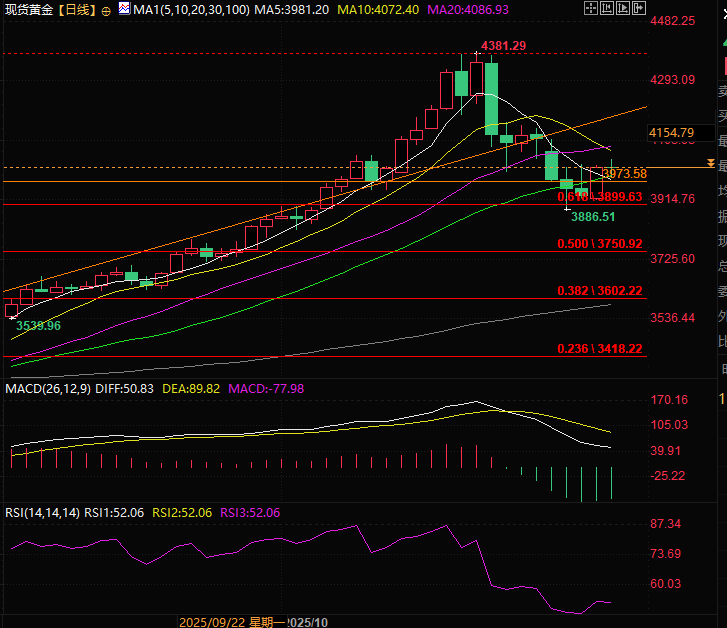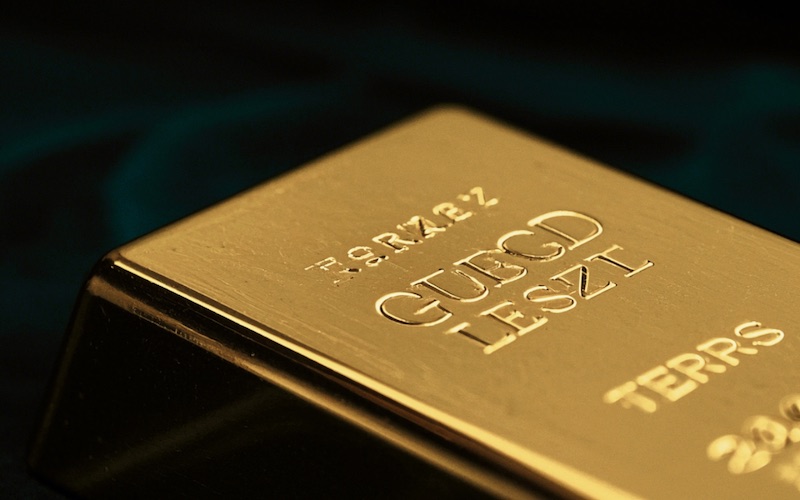Gold Review: A Terrifying Experience for Retail and Institutional Investors – Where Exactly is the Gold Price?
2025-10-31 15:40:05

This article reviews the acceleration and correction experienced by spot gold over the past two weeks, and provides an outlook on gold's future performance.
Fear of missing out amplifies risk aversion, driving the main upward trend in gold prices.
"Fear of missing out (FOMO) was extremely prevalent in the market," the World Gold Council (WGC) noted in its latest demand analysis report, referring to the previous price action as gold approached $4,400 per troy ounce. "This sentiment was particularly pronounced during the main upward trend in gold prices in September."
"This sentiment has further amplified the already strong inflow of safe-haven funds—funding flows that are primarily driven by global geopolitical risk premiums."
The risk aversion at the time stemmed from issues such as the US-China trade dispute, the Russia-Ukraine conflict, the Israeli-Palestinian conflict, and the US government shutdown.
"The missed opportunity for fear-driven capital inflows, coupled with continued safe-haven buying, jointly pushed up gold prices," the World Gold Council said in its latest third-quarter demand report. However, it also noted that gold supply simultaneously hit a quarterly high – mined gold production increased significantly, and recycled gold recovery also rebounded year-on-year. "Despite the large fluctuations in gold prices this time, the response of recycled gold recovery was surprisingly muted, below historical levels for the same period."
"As October draws to a close, North American mining and metals companies—primarily gold producers—have raised $2.9 billion through 185 financing deals," a recent market analysis noted. "This accelerated pace of financing will push the monthly IPO volume of listed companies in this sector to its highest level since November 2013."
Institutional selling was the main reason for the pullback, and the liquidity crisis in silver exacerbated panic selling.
In a trading strategy report, ICBC Standard Bank emphasized that "the pullback in gold prices was further amplified by large-scale ETF holdings liquidation, with the SPDR Gold ETF (GLD) experiencing a single-day outflow of $1 billion." It is particularly noteworthy that GLD is the world's largest gold ETF product in terms of assets under management.
Since GLD gold holdings hit a three-year peak of 1,058.7 tons at the beginning of last week, its holdings have decreased by a cumulative 22.6 tons, marking the largest single-week outflow recorded by the fund since July 2022.
Based on market capitalization, and coupled with the 6.7% drop in gold prices during the same period, the net liquidation corresponding to this outflow of funds reached $12.7 billion, marking the largest single-week (7 trading days) drop in net asset value (NAV) for the ETF since its inception next month, which will celebrate its 21st anniversary.
Just seven trading days prior, the fund had recorded a record $15.2 billion increase in net assets (NAV), demonstrating an extreme reversal of fortunes.
Meanwhile, spot silver rebounded above $48 per troy ounce on Thursday, pushing the dollar-denominated silver price up 5.2% in October, but it is still nearly $6 below the all-time high of $54 reached two weeks ago, a pullback of 11.1%.
"The premium for silver in the Indian market has fallen significantly, mainly due to the slowdown in end-user demand after the end of the holiday season in the past two weeks. This has directly led potential buyers to adopt a wait-and-see approach and postpone their purchases," ICBC Standard Bank analyzed in a report.
Information circulating on social media indicates that some coin retailers in the United States have "suspended silver purchases." Private holders revealed that, under the impact of a sudden wave of profit-taking, retailers are offering discounts of up to $5 per ounce or even higher on their silver buyback offers, leading to a temporary tightening of market liquidity.
At its annual meeting this week, the London Bullion Market Association (LBMA) highlighted the silver sell-off; this phenomenon indicates that U.S. silver refiners are urgently recasting retail-sized silver products into wholesale-standard silver bars, working with their European counterparts to cope with the pressure of concentrated liquidation at the retail end.
The Fed's hawkish rate cuts combined with easing trade tensions led to a final drop in gold prices.
Federal Reserve Chairman Jerome Powell announced an interest rate cut as expected at the October policy meeting last night (in line with market expectations), but then made it clear to the media that the probability of a further rate cut in December was "far from a certainty." After this statement, gold prices immediately fell from the $4,000 mark, dropping to a low of $3,915 per ounce.
While Powell's remarks reduced the probability of a December rate cut, they also suggested that QT was about to end and that the market was expected to remain in an accommodative tone given the US president's continued political interference and the fact that White House advisor Stephen Miran had joined the Federal Open Market Committee (FOMC).
Meanwhile, the high-level meeting between China and the US concluded the following day, and gold bears took profits, causing gold to rebound.
Gold Price Outlook
Gold prices have fallen significantly in less than two weeks, attracting some buyer interest. However, Bernard Dahdah, a market analyst at Natixis, warns investors that gold prices could still fall further.
In his latest research report, Dahda proposed three potential downside scenarios for gold: Ultimate Bottom: Dahda explicitly pointed out that the ultimate bottom for gold is close to the production cost, which is about $2,000 per ounce.
This price level is slightly above the mining sector's average comprehensive sustaining cost of around $1,600 per ounce. Weakening demand from central banks and ETF outflows: High gold prices may lead to a decline in central bank gold purchases, while gold ETFs may face further pressure from capital outflows.
In this scenario, gold prices may be suppressed to $2,800 per ounce. Stable investment demand and reduced central bank gold purchases: If investment demand remains relatively stable, but central banks reduce their gold purchases, gold prices may test the support level around $3,450 per ounce.
Despite the aforementioned scenario, Dahda believes that given the changes in the gold market in recent years, this scenario is unlikely to materialize. He points out that if gold prices fall below $3,400 per ounce, Chinese investors will enter the market in large numbers, and jewelry consumption demand will also see a strong rebound.
Despite Dahda's emphasis on downside risks, his baseline forecast is that gold prices will fluctuate within the current range throughout 2026. He expects the average gold price next year to remain around $3,800 per ounce.
Dahda believes that the current market lacks the momentum to support gold prices continuing to break through the $4,000 per ounce mark.
He explained that the previous surge in gold prices above this level was partly driven by a short squeeze, which has now largely subsided. For gold prices to continue rising, increased demand is needed, but this demand growth has not yet materialized at current price levels. Furthermore, previous market expectations of a significant weakening of the dollar and a substantial recession in the US economy are unlikely to materialize.
Dahda points out that although central bank gold purchases remain high, the pace of these purchases is expected to slow further due to persistently high gold prices. Analysts predict that global central bank gold purchases this year will be approximately 900 tons, slightly lower than the average of 1,000 tons per year over the past three years.
While Natixis maintains a relatively neutral outlook for gold in the new year, Dahda stated that he believes the upside risk for gold now outweighs the downside risk. He anticipates that investment demand will remain the core driver of the gold market in 2026.
He added that any volatility in the bond market could prompt investors to withdraw funds from short-term money market funds, potentially driving gold prices up by 10%. He concluded that the market remains highly uncertain, and the continuously rising US government debt is a key market variable to watch.
Technical Analysis:
Spot gold rebounded after retracing to the 0.618 Fibonacci retracement level. If it continues to close above 3973.58, it has a chance to continue rising, with resistance around 4100. If it fails to hold 3973.58, the price will likely retrace to the low of 3886.51, followed by the 0.5 Fibonacci retracement level around 3750, which is also the measured retracement level of the large head and shoulders pattern.

(Spot gold daily chart, source: FX678)
At 15:36 Beijing time, spot gold was trading at $4,119 per ounce.
- Risk Warning and Disclaimer
- The market involves risk, and trading may not be suitable for all investors. This article is for reference only and does not constitute personal investment advice, nor does it take into account certain users’ specific investment objectives, financial situation, or other needs. Any investment decisions made based on this information are at your own risk.





















